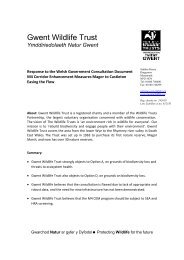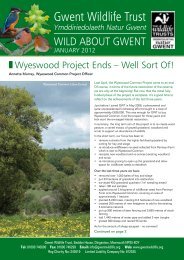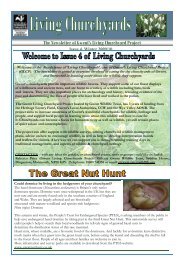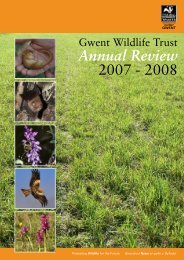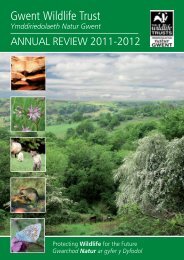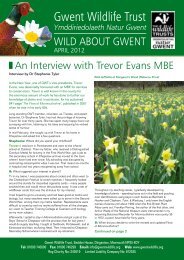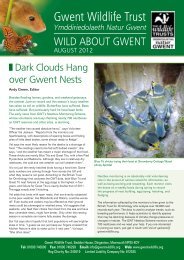Energy at any price? - Gwent Wildlife Trust
Energy at any price? - Gwent Wildlife Trust
Energy at any price? - Gwent Wildlife Trust
Create successful ePaper yourself
Turn your PDF publications into a flip-book with our unique Google optimized e-Paper software.
AT RISKLike m<strong>any</strong> visitingwaders, knot g<strong>at</strong>herin the Estuary inhuge flocksRefuge for birdsPREVIOUS PAGEThey arrive by the thousand, from Canada, Africa and Russia.And they come to the Estuary for food, rest and shelterIhave w<strong>at</strong>ched birds on theGloucestershire sector of the SevernEstuary since I was ten, when I made the50-mile round trip by bicycle everyweekend. Some early highlights arousefond memories: th<strong>at</strong> snow bunting in October1953, or the red-thro<strong>at</strong>ed diver <strong>at</strong> high tide inJanuary 1956. But it’s the regular visitorswhich leave the lasting impression.For example, Slimbridge is a winter refugefor white-fronted geese and thousands ofwigeon, teal and pintail, which migr<strong>at</strong>e everyyear from Russian breeding grounds to theterminus <strong>at</strong> the westernmost end of their3,000 mile flyway. In the cold winter of 1962they were joined by a massive arrival ofRussian Bewick’s swans, which havecontinued to come ever since, though like thewhitefronts their numbers have decreased.The Severn is also an essential refuellingstop for long distance migrants th<strong>at</strong> winter insub-Saharan Africa and pass through the UKtwice: in spring, on their way to Arcticbreeding grounds in Canada and the Russiantundra; then again in early autumn on theirway back. Waders like bar-tailed godwit orlittle stint use the short tundra summer toh<strong>at</strong>ch their young; within a few days the adultsleave, arriving on the Severn in l<strong>at</strong>e July orAugust before moving on to places such as theBanc d’Aguin in Mauritania, or even SouthAfrica. Their young find their own way amonth or so l<strong>at</strong>er.Quite apart from the navig<strong>at</strong>ional fe<strong>at</strong>, thephysiological performance is exceptional; bothyoung and adults put on half their bodyweight in f<strong>at</strong> to enable them to make theseThe adults leave their young inthe Arctic, arriving on the Severnin July before moving on to Africaflights. They use up this extra f<strong>at</strong> in migr<strong>at</strong>ion,so stops in biologically rich estuaries are vital.Then, having wintered in warmer climes, theyare back on the Estuary the following spring,together with other waders like whimbrelwhich g<strong>at</strong>her in the western UK to refuel, enroute to their Icelandic nesting grounds.In cold snaps the Estuary’s brackish w<strong>at</strong>erremains ice free, <strong>at</strong>tracting birds from inlandsites like the Somerset Levels or the SevernVale. Waders such as lapwing or goldenplover, together with ducks from riversidemarshes, flock to the Estuary <strong>at</strong> these times.In every way, then, the Severn Estuary is abird site for all seasons.Mike Smart, <strong>Trust</strong>eeGloucestershire <strong>Wildlife</strong> <strong>Trust</strong>Besides the huge flocks,the rarities. This is apomarine skua, pausinghalf way between the farNorth and the tropicsDavid Sl<strong>at</strong>erNEXT PAGE14 The <strong>Wildlife</strong> <strong>Trust</strong>s’ Severn Estuary reportThe <strong>Wildlife</strong> <strong>Trust</strong>s’ Severn Estuary report 15



